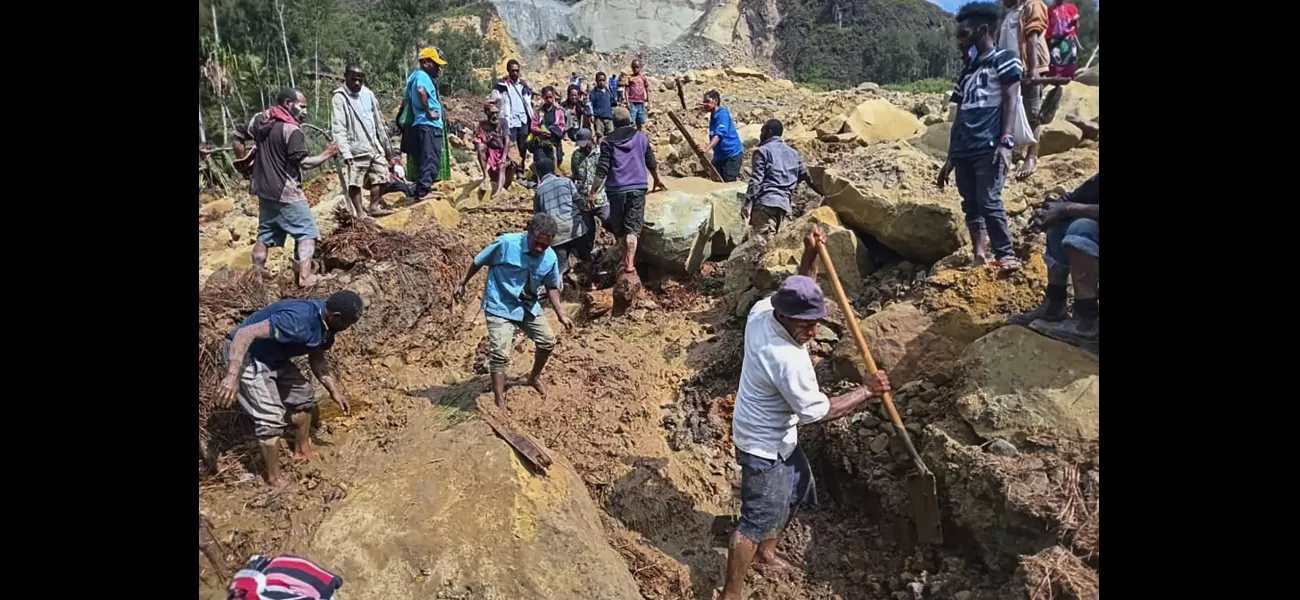Deadly landslide kills thousands and destroys village.
Officials report that people were tragically entombed in their sleep by a massive layer of mud and debris reaching eight meters deep.
May 27th 2024.

In a matter of moments, hundreds of homes were completely destroyed in Papua New Guinea. It was a devastating scene that left more than 2,000 people buried alive in their sleep. The local authorities reported that six villages in a remote area of the Pacific island nation were completely levelled in the early hours of Friday morning.
The extent of the destruction was immense, with a six-mile-wide area covered in a thick layer of mud, limestone, and debris from uprooted vegetation. It was estimated that around 150 homes were buried in just one village alone. The United Nations reported that only six people, including a child, were rescued alive from one neighborhood where 50 to 60 homes were destroyed.
The survivors who managed to escape the disaster returned to the scene to search desperately for their loved ones. However, the true scale of the tragedy was difficult to determine as many Papuans live in remote areas with little interaction with the national government. It was believed that many of the victims may not even be documented, as the area was known to be a safe haven for those displaced by nearby conflicts.
Initially, local officials reported around 100 deaths, but the UN estimated that the death toll was closer to 670 by the weekend. As more information became available, the disaster agency of Papua New Guinea revised the number even higher. They stated that over 2,000 people were buried alive and that the impact of the landslide had caused severe damage to buildings, food gardens, and the country's economic lifeline.
The disaster primarily affected six villages in the Maip Mulitaka region, which is a very remote and isolated area. The debris was so deep that it was nearly impossible to reach the affected areas by road. Helicopters were the only means of transportation, and survivors were seen making the journey on foot to return to the scene and search for their missing loved ones.
According to Serhan Aktoprak, the head of the local UN migration agency, the chances of finding survivors in the rubble were slim. He sadly stated, "Hopes to take the people out alive from the rubble have diminished now." The cause of the landslide was still unknown, but some speculated that it could be related to a 4.5 magnitude earthquake that had struck the area a week earlier.
Emergency convoys were dispatched to provide aid, including food, water, and other essentials. The Australian government, as Papua New Guinea's closest neighbor, stepped in to assist the local authorities and humanitarian agencies in their relief efforts. The road to recovery would be long and challenging, but the community was coming together to support each other and rebuild in the aftermath of this tragic natural disaster.
The extent of the destruction was immense, with a six-mile-wide area covered in a thick layer of mud, limestone, and debris from uprooted vegetation. It was estimated that around 150 homes were buried in just one village alone. The United Nations reported that only six people, including a child, were rescued alive from one neighborhood where 50 to 60 homes were destroyed.
The survivors who managed to escape the disaster returned to the scene to search desperately for their loved ones. However, the true scale of the tragedy was difficult to determine as many Papuans live in remote areas with little interaction with the national government. It was believed that many of the victims may not even be documented, as the area was known to be a safe haven for those displaced by nearby conflicts.
Initially, local officials reported around 100 deaths, but the UN estimated that the death toll was closer to 670 by the weekend. As more information became available, the disaster agency of Papua New Guinea revised the number even higher. They stated that over 2,000 people were buried alive and that the impact of the landslide had caused severe damage to buildings, food gardens, and the country's economic lifeline.
The disaster primarily affected six villages in the Maip Mulitaka region, which is a very remote and isolated area. The debris was so deep that it was nearly impossible to reach the affected areas by road. Helicopters were the only means of transportation, and survivors were seen making the journey on foot to return to the scene and search for their missing loved ones.
According to Serhan Aktoprak, the head of the local UN migration agency, the chances of finding survivors in the rubble were slim. He sadly stated, "Hopes to take the people out alive from the rubble have diminished now." The cause of the landslide was still unknown, but some speculated that it could be related to a 4.5 magnitude earthquake that had struck the area a week earlier.
Emergency convoys were dispatched to provide aid, including food, water, and other essentials. The Australian government, as Papua New Guinea's closest neighbor, stepped in to assist the local authorities and humanitarian agencies in their relief efforts. The road to recovery would be long and challenging, but the community was coming together to support each other and rebuild in the aftermath of this tragic natural disaster.
[This article has been trending online recently and has been generated with AI. Your feed is customized.]
[Generative AI is experimental.]
0
0
Submit Comment





